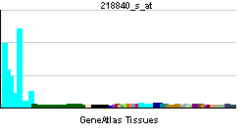- NADSYN1
-
NAD synthetase 1 Identifiers Symbols NADSYN1; FLJ10631; FLJ36703; FLJ40627 External IDs OMIM: 608285 MGI: 1926164 HomoloGene: 6098 GeneCards: NADSYN1 Gene EC number 6.3.5.1 Gene Ontology Molecular function • nucleotide binding
• NAD+ synthase (glutamine-hydrolyzing) activity
• protein binding
• ATP binding
• hydrolase activity, acting on carbon-nitrogen (but not peptide) bonds
• ligase activityCellular component • cytosol Biological process • vitamin metabolic process
• water-soluble vitamin metabolic process
• nitrogen compound metabolic process
• NAD biosynthetic process
• NAD metabolic processSources: Amigo / QuickGO RNA expression pattern 
More reference expression data Orthologs Species Human Mouse Entrez 55191 78914 Ensembl ENSG00000172890 ENSMUSG00000031090 UniProt Q6IA69 Q8BL34 RefSeq (mRNA) NM_018161 NM_030221.1 RefSeq (protein) NP_060631 NP_084497.1 Location (UCSC) Chr 11:
71.16 – 71.24 MbChr 7:
150.98 – 151.01 MbPubMed search [1] [2] Glutamine-dependent NAD(+) synthetase is an enzyme that in humans is encoded by the NADSYN1 gene.[1][2]
Nicotinamide adenine dinucleotide (NAD) is a coenzyme in metabolic redox reactions, a precursor for several cell signaling molecules, and a substrate for protein posttranslational modifications. NAD synthetase (EC 6.3.5.1) catalyzes the final step in the biosynthesis of NAD from nicotinic acid adenine dinucleotide (NaAD).[2]
References
- ^ Hara N, Yamada K, Terashima M, Osago H, Shimoyama M, Tsuchiya M (Mar 2003). "Molecular identification of human glutamine- and ammonia-dependent NAD synthetases. Carbon-nitrogen hydrolase domain confers glutamine dependency". J Biol Chem 278 (13): 10914–21. doi:10.1074/jbc.M209203200. PMID 12547821.
- ^ a b "Entrez Gene: NADSYN1 NAD synthetase 1". http://www.ncbi.nlm.nih.gov/sites/entrez?Db=gene&Cmd=ShowDetailView&TermToSearch=55191.
Further reading
- Maruyama K, Sugano S (1994). "Oligo-capping: a simple method to replace the cap structure of eukaryotic mRNAs with oligoribonucleotides.". Gene 138 (1–2): 171–4. doi:10.1016/0378-1119(94)90802-8. PMID 8125298.
- Suzuki Y, Yoshitomo-Nakagawa K, Maruyama K, et al. (1997). "Construction and characterization of a full length-enriched and a 5'-end-enriched cDNA library". Gene 200 (1–2): 149–56. doi:10.1016/S0378-1119(97)00411-3. PMID 9373149.
- Dias Neto E, Correa RG, Verjovski-Almeida S, et al. (2000). "Shotgun sequencing of the human transcriptome with ORF expressed sequence tags". Proc. Natl. Acad. Sci. U.S.A. 97 (7): 3491–6. doi:10.1073/pnas.97.7.3491. PMC 16267. PMID 10737800. http://www.pubmedcentral.nih.gov/articlerender.fcgi?tool=pmcentrez&artid=16267.
- Strausberg RL, Feingold EA, Grouse LH, et al. (2003). "Generation and initial analysis of more than 15,000 full-length human and mouse cDNA sequences". Proc. Natl. Acad. Sci. U.S.A. 99 (26): 16899–903. doi:10.1073/pnas.242603899. PMC 139241. PMID 12477932. http://www.pubmedcentral.nih.gov/articlerender.fcgi?tool=pmcentrez&artid=139241.
- Ota T, Suzuki Y, Nishikawa T, et al. (2004). "Complete sequencing and characterization of 21,243 full-length human cDNAs". Nat. Genet. 36 (1): 40–5. doi:10.1038/ng1285. PMID 14702039.
- Lehner B, Sanderson CM (2004). "A Protein Interaction Framework for Human mRNA Degradation". Genome Res. 14 (7): 1315–23. doi:10.1101/gr.2122004. PMC 442147. PMID 15231747. http://www.pubmedcentral.nih.gov/articlerender.fcgi?tool=pmcentrez&artid=442147.
- Gerhard DS, Wagner L, Feingold EA, et al. (2004). "The Status, Quality, and Expansion of the NIH Full-Length cDNA Project: The Mammalian Gene Collection (MGC)". Genome Res. 14 (10B): 2121–7. doi:10.1101/gr.2596504. PMC 528928. PMID 15489334. http://www.pubmedcentral.nih.gov/articlerender.fcgi?tool=pmcentrez&artid=528928.
- Rual JF, Venkatesan K, Hao T, et al. (2005). "Towards a proteome-scale map of the human protein-protein interaction network". Nature 437 (7062): 1173–8. doi:10.1038/nature04209. PMID 16189514.
Categories:- Human proteins
- Chromosome 11 gene stubs
Wikimedia Foundation. 2010.
